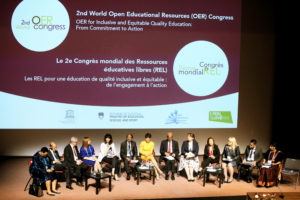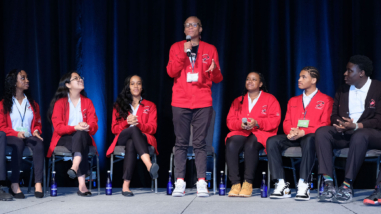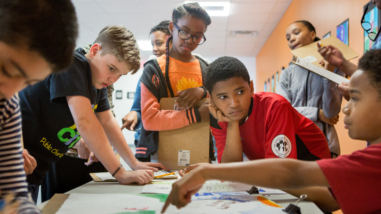“We really appreciate that the whole world is here, and that we are all supporting OER development,” Dr. Maja Makovec Brenčič, Slovenia’s minister of education, science and sport, said to me recently at the 2nd World OER Congress.
It was the second morning of a three-day convening held in Ljubljana, Slovenia, which drew over 550 government leaders, policy experts, practitioners, and advocates from more than 140 countries. Dr. Makovec Brenčič was enthusiastic about the growing commitment to action from those in attendance.
The event—hosted by the government of Slovenia and United Nations Educational, Science and Cultural Organization (UNESCO)—was organized to draw attention to the role that open educational resources can play in achieving one of the UN sustainable development goals to ensure inclusive and equitable quality education for all.

Over the past 15 years, interest in OER—freely available educational materials that can be downloaded, edited and shared—has steadily grown as promising new practices and examples come to light. Those gathered celebrated the wide range of innovative efforts currently underway, and began to outline solutions to the many challenges that need to be addressed in order to see this work to move forward and scale.
From the very beginning, UNESCO has been involved with the OER movement. In an opening video at the Congress, Irina Bokova, deputy general of UNESCO, highlighted how her organization helped to coin the term back in 2002. Five years later, a small group of open education advocates convened in Cape Town called upon educators, authors, publishers and institutions to share their educational resources and develop supporting policies.
These initial efforts culminated in UNESCO’s convening of the 1st World OER Congress in 2012, where the organization called upon governments around the world to promote more equal access to information.
According to the Commonwealth of Learning’s new 2017 global report, more governments have expressed interest in adopting policies to promote the development and use of OER. During that first convening in 2012, four ministers of education spoke of the potential benefits from openly licensed resources.
Now, five years later, this 2nd Congress featured a panel discussion with over a dozen ministers. Each minister spoke to the ways in which OER factors into their strategy for expanding access to content learning, as well as the critical challenges for implementation.
To date, however, much of the progress has been made on a smaller scale outside of governments. One promising initiative that drew significant attention was the African Storybook Project, developed by the South African Institute for Distance Education (Saide), a nonprofit based in Johannesburg, South Africa.
Getachew Engida, deputy director-general for UNESCO, spoke of the tremendous need for books in primary schools across Sub-Saharan Africa. The African Storybook website features openly licensed, illustrated stories that are free to use, copy, translate, adapt and print. The website features 843 storybooks that are available in more than 100 languages. As Engida said, “the capability to translate into local languages and contexts make these resources more relevant.”
Projects like this demonstrate the promise of OER, but government representatives and policy experts gathered highlighted several challenges that have made it difficult to bring this work to scale. One such challenge is the continued confusion over the meaning of “open.” For many, it was still difficult to distinguish between digital resources that were available for free, and those that were openly licensed to provide users with the permission to keep, reuse and adapt the materials to meet their own needs.
A second key challenge that has confronted many countries is developing the necessary expertise to find, use and share OER.
Ryan Merkley, chief executive officer of Creative Commons—the nonprofit responsible for developing and maintaining the most widely used open content licenses—sees a role for his organization in helping to build this capacity. “We think there will be a much higher demand for expertise in how you work openly, how you build open communities, how you collaborate,” Merkley said to me. To address this need, his organization is developing a CC Certificate that will allow users to gain the knowledge and skills they need, and show their expertise.
Despite these difficulties, those gathered saw a clear line of progress over the last decade. “It’s no longer about justifying the existence of OER,” said Tibor Navracsics, European commissioner for education, culture, youth and sport. Instead, he said, it is now about how to effectively and sustainably use OER on the ground.
To Merkley, a critical part of making this work sustainable includes widespread government adoption of open policy. “What we’d like to see is more of the systemic, structural change where every country has an oar in the water on an open policy, and sees that as a meaningful lever toward a process of changing the way they do education,” he said.
There is a real case to be made for embracing new strategies and approaches in education. While literacy rates continue to climb around the world, more than 750 million adults and 264 million young people who are not currently in school aren’t equipped with basic literacy skills—that is, more than one eighth of the global population cannot read or write. To meet the needs of the global community, educators and learners around the world must be able to access the necessary resources to develop these foundational skills.
For Makovec Brenčič, the Slovenian education minister, this was the most important reason for hosting the 2nd World OER Congress: “OER is one of the ways to make education really inclusive, accessible, and open to everyone.”
Editor’s note: Lindsey Tepe is a senior policy analyst with the Education Policy Program at New America, a grantee of the Hewlett Foundation.




